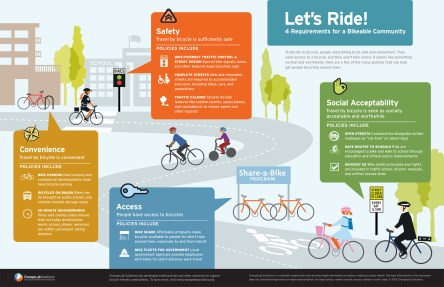American cities are changing for the better. More pedestrian-friendly cities have popped up in the last decade promoting cleaner air, less traffic, and healthier residents. The option for walking and biking tops renters’ must-have lists and neighborhoods that don’t adapt to this new lifestyle are losing out. Is your property in a bikeable community? What makes a bikeable community? This infographic from Good.Is illustrates the four traits needed for bikeability. If your community has all of these features, then you’re on the right track! You’ll attract Millennials and Baby Boomers alike to your property. If not, you have the power to promote change. But why should you bother? Demand is the largest factor; renters want pedestrian-friendly locations. When renters hear pedestrian-friendly, they also hear: Cleaner air Less traffic Less time in traffic means less stress and more time with family Outdoor fitness options Easier access to shops, services, and parks…and fewer ugly parking decks Money saved! No car, car insurance, or outlandish gas budgets required Money saved means more cash for personal interests Neighborhoods that aren’t bikeable or walkable don’t offer these advantages. They will plummet to the bottom of apartment seekers’ lists when compared to communities that do. To start, you’ll need to rally and unify local residents through education. You will want to connect with organizations such as America Bikes, which advocates for bike and pedestrian initiatives under the federal transportation bill. They can help you with funding, case studies, feasibility studies, and other reports that you will need to inform residents and impress city officials. Organizations such as The League of American Bicyclists and Rails to Trails Conservancy are excellent resources for educational materials and ideas to put existing infrastructure to work. Many offer to send representatives to your community to...
City Cycling
Insight from John Pucher
When given the choice to drive, walk, take the bus or ride a bicycle, which do you choose? Urban transit expert John Pucher is trying to push more people out the door on their own two feet – and pedals. Given that 41 percent of trips taken in the U.S. amount to less than 2 miles of travel each way, cycling as a daily transportation method should be easily viable (it’s fun, healthy and very green), but adopting such habits is hard for many of us (we’re sedentary and addicted to our cars). In no U.S. city does cycling yet edge into double digit percentages of trips taken. Pucher, a professor of urban planning at Rutgers University, focuses his attention on how humans get around hopes that better planning efforts and increased advocacy will change that. His latest book, “City Cycling,” co-authored with Ralph Buehler of Virginia Tech, is an examination of urban cycling trends around the world. He spoke recently in support of the text in Santa Barbara, Calif. For multifamily housing developers and managers, the question of how people get from place to place in their communities is an important one. If residents choose cycling, walking or public transit over a private vehicle, the shift can be beneficial for developers. It may eventually even mean they can provide less parking – as long as there is designated space for bike storage. For residents adopting a bike, transit and pedestrian-heavy lifestyle, the most attractive community locations will be closer to the city core. It’s no surprise that European cities, especially Amsterdam and Copenhagen, top most lists of places where big chunks – nearly 30 percent for Copenhagen – of trips are taken on bikes. Denmark’s largest city is working to raise that number...


